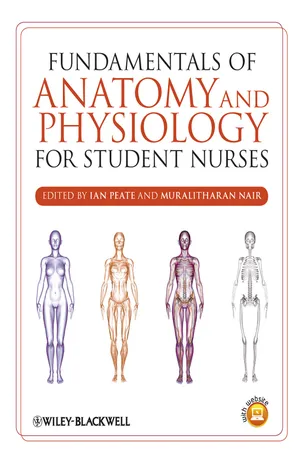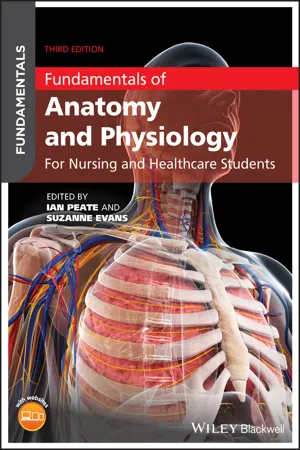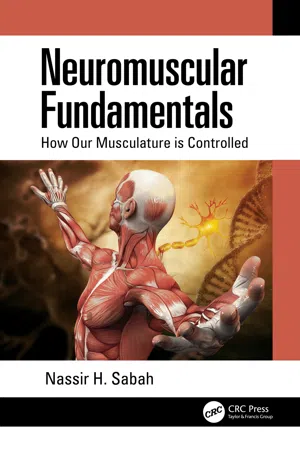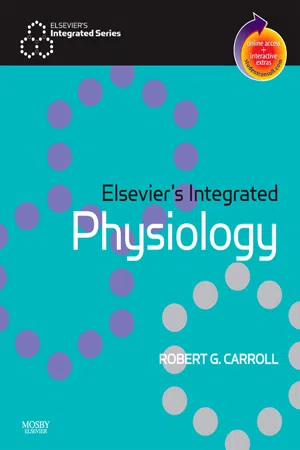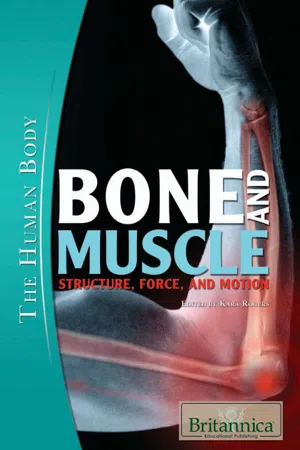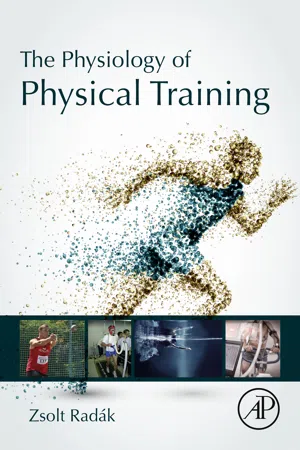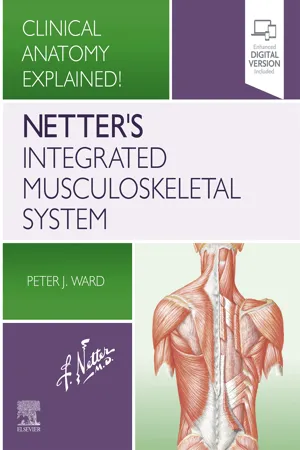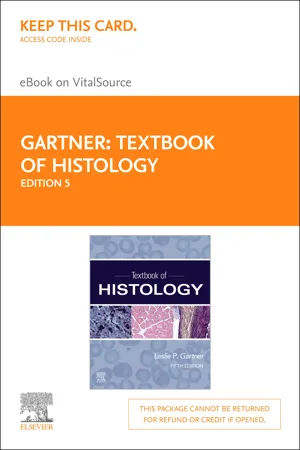Biological Sciences
Skeletal Muscle
Skeletal muscle is a type of muscle tissue that is attached to bones and is responsible for voluntary movements of the body. It is striated in appearance due to the arrangement of its protein filaments. Skeletal muscle is under conscious control and is involved in activities such as walking, running, and lifting objects.
Written by Perlego with AI-assistance
Related key terms
Related key terms
1 of 4
Related key terms
1 of 3
10 Key excerpts on "Skeletal Muscle"
- Ian Peate, Muralitharan Nair(Authors)
- 2011(Publication Date)
- Wiley-Blackwell(Publisher)
Cardiac muscle, found only in the heart, is also a form of involuntary muscle and forms the walls of the heart. Its main function is to propel blood into the circulation by making the right atrium contract. Cardiac muscles also have a single nucleus, are striated, branched and tubular. Cardiac muscle is discussed in more detail in Chapter 10.SkeletalThe Skeletal Muscles make up the muscular system of the body (composed of over 600 muscles) and account for 40–50% of the body weight in an adult. The Skeletal Muscles are the only voluntary muscles of the body (i.e. are consciously controlled) and are the muscles involved in moving bones and generating external movement. Skeletal Muscle is also referred to as striped or striated muscle because of the banded patterns of the cells seen under the microscope.Table 9.1 provides a summary of the different types of muscle tissue.As both smooth and cardiac muscle are discussed in more detail elsewhere, the rest of this chapter will focus on Skeletal Muscle only.Functions of the muscular systemThe muscular system plays four important roles in the body:- Maintains posture
- Produces movement
- Stabilises joints
- Generates heat.
Table 9.1Different types of muscle tissueSkeletal Muscle Smooth muscle Cardiac muscle Attached to bones or the skin (facial muscles only) Found in the walls of hollow visceral organs and blood vessels Located in the walls of the heart Single, long cylindrical cells Single, narrow, rod-shaped cells Branching chains of cells Striated, multinucleated cells Non-striated, uninucleated cells Non-striated, uninucleated cells Under voluntary control Involuntary control Involuntary control Maintenance of body postureDespite the continuous downward pull of gravity, the body is able to maintain an erect or seated posture because of the continuous tiny adjustments that the Skeletal Muscles make.Production of movementThe body’s ability to mobilise is a result of Skeletal Muscle activity and muscle contraction as when muscles contract they pull on the tendons and bones of the skeleton to produce movement.Stabilisation of jointsMuscle tendons play a vital role in stabilising and reinforcing the joints of the body. During movement the Skeletal Muscles pull on bones which stabilise the joints of the skeleton.- No longer available |Learn more
Exercise Physiology
for Health and Sports Performance
- Nick Draper, Helen Marshall(Authors)
- 2014(Publication Date)
- Routledge(Publisher)
Skeletal Muscle is the only muscle type that can be voluntarily contracted and is the form of tissue that enables bodily movement by contracting against the skeleton (hence the name). The human body is comprised of between 600 and 700 muscles which vary in size from 1 mm (such as those found attached to the bones of the ear) to 30 cm long in the sartorius muscle of the thigh.Figure 5.8 The three types of muscle tissue.Key point
There are three types of muscle tissue:- skeletal
- smooth
- cardiac
Cardiac and Skeletal Muscle are striated (striped) in appearance, meaning they have microscopic light and dark patches within their structure. These striations are due to the specific arrangement of the proteins that enable muscular contraction. This will become clearer when the structure of Skeletal Muscle is discussed in the following section. As can be seen from Figure 5.8 , smooth muscle is the only non-striated muscle tissue. While Skeletal Muscle tissue is multi-nucleate, due to its relatively long fibres, cardiac and smooth muscle fibres are shorter and have only one nucleus.In addition to its role in movement, muscle tissue has several other functions. All are listed below.- movement of both substances within the body (blood and food) and of the body as a whole.
- stability – the ability to stop the body moving to stabilise the body when standing or sitting.
- storage of oxygen and nutrients such as glycogen for energy production.
- production of heat – a by-product of energy-generating reactions that take place within muscle fibres, which serves to assist in the maintenance of body temperature.
- protection and support of vital organs, such as those in the abdomen, by the surrounding muscle tissue.
- regulation of sphincters at the entrance and exit of various tracts, such as the digestive and urinary tracts.
Skeletal Muscle anatomy
When reading and talking about Skeletal Muscle many words are used that specifically relate to muscle. These are identified by the prefixes myo, meaning muscle, and sarco - eBook - ePub
Fundamentals of Anatomy and Physiology
For Nursing and Healthcare Students
- Ian Peate, Suzanne Evans(Authors)
- 2020(Publication Date)
- Wiley-Blackwell(Publisher)
Muscle tendons play a vital role in stabilising and reinforcing the joints of the body. During movement the Skeletal Muscles pull on bones which stabilise the joints of the skeleton.Protection and Control of Internal Tissue Structures/Organs
Skeletal Muscle plays an important role in protecting the internal organs as the visceral organs and internal tissues contained within the abdominal cavity are protected by layers of skeletal tissue within the abdominal wall and floor of the pelvic cavity. Similarly, the orifices contained within the digestive and urinary tracts are encircled by Skeletal Muscle, and this allows for voluntary control over swallowing, urination and defaecation (Martini and Bartholomew, 2017 ).Generation of Heat
Heat generation is vital in maintaining normal body temperature, and Skeletal Muscles, which account for 40% of the body’s mass, are the muscle type mostly responsible for the body’s heat generation. During muscle contraction, adenosine triphosphate (ATP) is used to release the needed energy, with nearly three‐quarters of its energy escaping as heat.Composition of Skeletal Muscle Tissue
As muscles contain other types of tissues, such as blood vessels and connective and nervous tissue, they are considered to be organs (Logenbaker, 2017 ). Each cell in Skeletal Muscle tissue is known as a single muscle fibre, which, owing to its large size, contains hundreds of nuclei (i.e. are multinucleate). A Skeletal Muscle consists of individual muscle fibres that are markedly different from a ‘typical’ cell (not least by their size) bundled into fascicles and surrounded by three layers of connective tissue.Clinical Considerations Rhabdomyolysis
- eBook - ePub
Neuromuscular Fundamentals
How Our Musculature is Controlled
- Nassir H. Sabah(Author)
- 2020(Publication Date)
- CRC Press(Publisher)
striated muscle because of its distinctive appearance under the microscope as explained later, is the largest tissue in the body, accounting in humans for more than 40% of total body weight of a lean adult. Most of the approximately 640 Skeletal Muscles of the human body directly attach to the bony skeleton – but not all, as in the case of some tongue and abdominal muscles which attach to other muscles. Muscle size varies widely, from the tiny stapedius muscle of the middle ear to the gluteus maximus of the buttocks, whose volume is about 1000 ml in a human adult. The primary function of Skeletal Muscle is in the execution of movement and the maintenance of posture. In addition, Skeletal Muscle can serve important communicative functions, as in making facial expressions and in speech production, as well as some important secondary functions. For example, layers of Skeletal Muscle in the abdominal wall and the floor of the pelvic cavity protect and support the weight of visceral organs. Muscular contraction in the form of shivering is very effective in rapidly increasing heat production in the body to combat outside cold. Although Skeletal Muscle is essentially under voluntary control, it can be involved in many involuntary activities, such as eye blinking, breathing, shivering, and reflex action.A Skeletal Muscle is basically a grouping of several thousand to several million individual muscle fibers of 10–100 µm diameter and of length in the range of one millimeter or so in the smallest Skeletal Muscle, the stapedius muscle of the inner ear, but can be as long as 60 cm in the human sartorius muscle that extends obliquely over the thigh. Although they are often described as single muscle cells, individual muscle fibers are in fact formed during embryonic development from the fusion of progenitor cells known as myoblasts . They are therefore multinucleated, with hundreds to thousands of nuclei in longer fibers. Muscle fibers are typically cylindrical in shape, circular or oval in cross section, with conical ends. It is estimated that the human body contains more than 108 muscle fibers. Muscle fibers are also known as myocytes or myofibers .The cell membrane of the muscle fiber is the sarcolemma and has the ionic properties characteristic of excitable cells, manifested as a resting membrane voltage of about –90 mV and the ability to generate and propagate a muscle action potential. The sarcolemma is coated on the outside by a basement membrane formed largely of glycoproteins, and each muscle fiber is surrounded by a delicate layer of connective tissue, the endomysium (Figure 9.1 ). Groups of about 10 to more than 100 muscle fibers are bundled together into fascicles , the number of muscle fibers in a fascicle being larger in muscles that produce greater force, with less fineness of control. Fascicles are surrounded, in turn, by another layer of connective tissue, the perimysium . The whole muscle is ensheathed by a dense layer of irregular connective tissue, the epimysium - eBook - ePub
- Robert G. Carroll(Author)
- 2006(Publication Date)
- Mosby(Publisher)
Skeletal Muscle cells, which account for 40% to 50% of body weight, are a major storage pool for body K +. Skeletal Muscle also plays a major role in metabolism and in temperature regulation. Cardiac and smooth muscle support the activities of the cardiovascular, respiratory, GI, and renal systems. Cardiac muscle generates the pressure that propels blood through the body (see Chapter 7). Smooth muscle also regulates movement of numerous substances, including blood, within the body. GI smooth muscle controls gastric motility (see Chapter 12). Respiratory airway smooth muscle determines airway resistance to airflow (see Chapter 10). Vascular smooth muscle controls resistance to blood flow (see Chapters 8 and 9). This chapter describes the normal function of skeletal and smooth muscle as a tissue. STRUCTURE OF Skeletal Muscle Skeletal Muscle is attached to the bones of the skeleton by very thin extensions of fascia or by tendons. Tendons (fibrous cords) make strong connections to bone. The contraction of Skeletal Muscle exerts force on bones or skin and moves them. Most Skeletal Muscles are under voluntary control of the nervous system. Skeletal Muscle is composed of successively smaller structures: the muscle fascicle, muscle fiber, and finally myofibrils. Skeletal Muscle has a regular arrangement of actin (I band) and myosin (A band) filaments, giving it a striated appearance. Myofibrils are attached to each other within the I band at the Z disk. Actin filaments are composed of actin, tropomyosin, and troponin proteins. Myosin filaments are composed of myosin proteins. Titin is a structural protein that provides an elastic connection between the opposing ends of the actin and myosin filaments (Fig. 5-2). Figure 5-2 Skeletal Muscle can be broken down into progressively smaller units, ending with the functional unit of the sarcomere. The histology of the sarcomere is based on the regular arrangement of thin and thick filaments, containing actin and myosin, respectively - eBook - ePub
Bone and Muscle
Structure, Force, and Motion
- Britannica Educational Publishing, Kara Rogers(Authors)
- 2010(Publication Date)
- Britannica Educational Publishing(Publisher)
HE NATURE OF MUSCLET he human body contains three primary types of muscle tissue known as striated, smooth, and cardiac. These types are distinguished based on their cellular structure and anatomical locations. The organization of cells within the different types of muscle fibres influences how a muscle functions. For example, cellular organization determines the speed of muscle contraction, with those cells in Skeletal Muscle tissue being organized in a way that facilitates rapid contraction and those cells in smooth muscle tissue being designed in a way that limits contraction speed but enables involuntary contraction. Factors such as nutrient supply and utilization by individual muscle cells also play a major role in influencing muscle function.Cross section of Skeletal Muscle highlighting the component elements of one muscle fibre . Nucleus Medical Art, Inc./Getty ImagesSTRIATED MUSCLE
Striated, or striped, muscle constitutes a large fraction of the total body weight in humans. Striated muscle contracts to move limbs and maintain posture. Both ends of most striated muscles articulate the skeleton and thus are often called Skeletal Muscles. They are attached to the bones by tendons, which have some elasticity provided by the proteins collagen and elastin, the major chemical components of tendons.Each striated muscle has blood vessels and nerves associated with it. The vessels transport blood to and from the muscle, supplying oxygen and nutrients and removing carbon dioxide and other wastes. The signals that initiate contraction are sent from the central nervous system to the muscle via the motor nerves. Muscles also respond to hormones produced by various endocrine glands; hormones interact with complementary receptors on the surfaces of cells to initiate specific reactions. Each muscle also has important sensory structures called stretch receptors, which monitor the state of the muscle and return the information to the central nervous system. Stretch receptors are sensitive to the velocity of the movement of the muscle and the change in length of the muscle. They complete a feedback system that allows the central nervous system to assess muscular movement and to adjust motor signals in light of the movement. - eBook - ePub
- R. Michael Akers, D. Michael Denbow(Authors)
- 2013(Publication Date)
- Wiley-Blackwell(Publisher)
involuntary striated muscles , respectively.The prefixes myo and sarco refer to muscle. Therefore, terms such as myofibril or myofilament reference structures within a muscle. For example, the plasma membrane of a muscle cell is called the sarcolemma , the cytoplasm the sarcoplasm , and the endoplasmic reticulum the sarcoplasmic reticulum (SR). In addition, a single Skeletal Muscle cell is also called a muscle fiber .Properties of muscles
Four properties of muscles enable them to perform their functions. These properties include- Excitability. Sometimes called irritability. Muscle cells maintain a membrane potential and are able to respond to a stimulus such as a neurotransmitter by developing an electrical impulse. The stimulus is usually neurochemical, but can also be mechanical or chemical. The electrical impulse can migrate across the sarcolemma.
- Contractility . When stimulated, the electrical impulse spreading across a muscle cell can cause the cell to contract.
- Extensibility. In addition to contraction, muscle cells can lengthen in response to stretch. This is more evident in smooth muscle compared to Skeletal Muscle.
- Elasticity. Once stretched, muscle fibers can recoil to their original resting length due to the elastic elements within the muscle.
Functions of muscles
Muscles serve four major functions, including production of movement, maintenance of posture, stabilization of joints, and generation of heat:- Production of movement. One feature unique to animals compared with plants is their ability to move. The action of Skeletal Muscle is responsible for moving joints and thus allowing locomotion. However, movement can be viewed more broadly than locomotion. An animal can change its posture or facial features as a result of muscle contraction. In addition, generally as a result of smooth or cardiac muscle contraction, materials can be relocated within the body. For example, contraction of the heart helps propel blood through the vessels; contraction of the bladder or gastrointestinal tract
- eBook - ePub
- Zsolt Radák(Author)
- 2018(Publication Date)
- Academic Press(Publisher)
Chapter 2Skeletal Muscle, Function, and Muscle Fiber Types
Abstract
This chapter discusses the characteristics of Skeletal Muscle, which determine sport performance and health. Skeletal Muscle is capable of adaptation which is visible to the human eye—for example, muscle hypertrophy. The condition of the musculature determines our locomotion and our quality of life.Keywords
Skeletal Muscle; Muscle hypertrophy; Muscle fibers; Sarcomere; Muscle contraction; TendonsThis chapter discusses the characteristics of Skeletal Muscle, which determine sport performance and health. Skeletal Muscle is capable of adaptation which is visible to the human eye—for example, muscle hypertrophy. The condition of the musculature determines our locomotion and our quality of life.Skeletal Muscle is specialized for locomotion and also has an important role in sugar and lipid metabolism, and affects the immune system. The two other types of muscle, cardiac muscle and smooth muscle, are not covered in this chapter. Each anatomically distinguishable muscle is surrounded by connective tissue called epimysium, and is built up by fascicles surrounded by perimysium. Muscle fascicles are built up by muscle fibers, which are limited by endomysium (Fig. 2.1 ).Fig. 2.1 Structure of Skeletal Muscle. The architecture of the Skeletal Muscle is perfectly structured anatomically.Muscle fibers, which are also called myocytes, are specialized units since they have several nuclei, which are located under the sarcolemma. In the sarcomere, which is the basic functional unit of Skeletal Muscle, thin and thick myofibrils are responsible for locomotion and are arranged in a strict repeating order. Sarcomeres are divided by Z-lines (Fig. 2.2 ).Fig. 2.2 - eBook - ePub
- Peter J. Ward(Author)
- 2021(Publication Date)
- Elsevier(Publisher)
Myosatellite cells are small cells with minimal cytoplasm that are located alongside the skeletal myocytes. They are typically quiescent but can become active and proliferate to form additional myosatellite and myocyte cells in response to increased exercise or muscle trauma. In adults, they do not form new muscle from scratch but fuse to add their nuclei and cytoplasm to nearby myocytes.Skeletal Muscle (Fig. 6.11 )
Skeletal Muscles are generally under voluntary control and contract in response to signals from lower motor neurons in the spinal cord. Each Skeletal Muscle cell, or muscle fiber , is shaped like an elongated cylinder that sits side by side with neighboring muscle fibers. Each muscle fiber (individual cell) is surrounded by a thin layer of connective tissue, the endomysium , that is largely composed of reticular fibers. Several muscle fibers and their surrounding endomysium are bundled together into muscle fascicles that are surrounded by a thicker layer of connective tissue, the perimysium . The outermost layer of connective tissue covering an entire muscle is called the epimysium . All the connective tissues within a muscle are continuous with each other, the muscle tendon, periosteum, and collagen fibers within the bone onto which they insert.Before we get rolling, please note that the prefix “sarco-” is derived from the Greek “sarx” for “flesh” and is used extensively when describing the features of Skeletal Muscle cells. For example, sarcopenia refers to the loss of muscle mass (approximately 3% per decade) that tends to occur due to decrease in muscle activity with age. The cell membrane of Skeletal Muscle cells is called the sarcolemma , and it surrounds the cell’s cytoplasm, or sarcoplasm . One peculiar aspect of the sarcolemma is that it forms deep channels called T tubules (or transverse tubules if you are not into the whole brevity thing) through the sarcoplasm, extending from one side of the sarcolemma to the other. Because of this, the inside of each T tubule is actually filled with extracellular fluid. Each muscle fiber also contains many nuclei (hundreds in a single fiber), mitochondria that produce copious amounts of adenosine triphosphate (ATP), myoglobin to store O2 , and glycogen and triglycerides as a source of energy. The majority of the sarcoplasm is taken up by myofibrils - eBook - ePub
- Leslie P. Gartner(Author)
- 2020(Publication Date)
- Elsevier(Publisher)
8Muscle
Muscle cells are specialized for contraction that permits movement. Organisms harness the contraction of muscle cells and the arrangement of the extracellular components of muscle to permit locomotion, constriction, pumping, and other propulsive movements.Muscle cells are called striated or smooth muscle depending on the respective presence or absence of a regularly repeated arrangement of myofibrillar contractile proteins, the myofilaments. Striated muscle cells display characteristic alternations of light and dark cross-bands, which are absent in smooth muscle. There are two types of striated muscle: Skeletal Muscle , accounting for most of the voluntary muscle mass of the body and approximately 40% of the total body weight, and involuntary cardiac muscle , limited almost exclusively to the heart. The bulk of smooth muscle is located in the walls of blood vessels, the walls of viscera, and in the dermis of the skin.Unique terminology is often used to describe the components of muscle cells. Thus, muscle cell membrane is referred to as sarcolemma , the cytoplasm as sarcoplasm , the smooth endoplasmic reticulum (SER) as sarcoplasmic reticulum , and the mitochondria are occasionally known as sarcosomes . Because they are much longer than they are wide, muscle cells frequently are called muscle fibers ; however, unlike collagen and elastic fibers, they are living entities.All three muscle types are derived from mesoderm. Cardiac muscle originates in splanchnopleuric mesoderm, most smooth muscle is derived from splanchnic and somatic mesoderm, and most Skeletal Muscles originate from somatic mesoderm.Skeletal Muscle
Skeletal Muscle is composed of long, cylindrical, multinucleated cells that undergo voluntary contraction to facilitate movement of the body or its parts.During embryonic development, several hundred myoblasts , precursors of Skeletal Muscle fibers, line up end to end, fusing to form long multinucleated cells known as myotubes . These newly formed myotubes manufacture cytoplasmic constituents, as well as the contractile elements of muscle, called myofibrils . Myofibrils are composed of specific arrays of myofilaments
Index pages curate the most relevant extracts from our library of academic textbooks. They’ve been created using an in-house natural language model (NLM), each adding context and meaning to key research topics.
Explore more topic indexes
Explore more topic indexes
1 of 6
Explore more topic indexes
1 of 4
